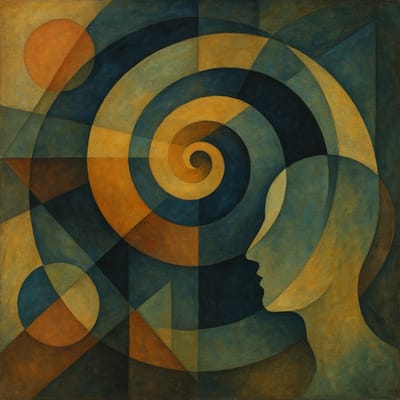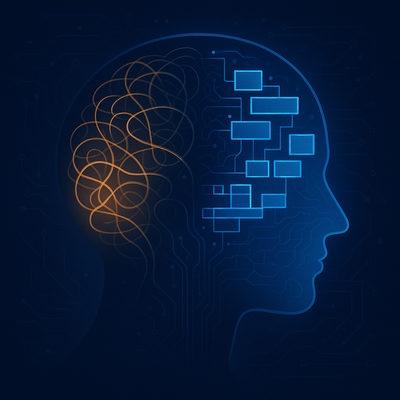Bürhân I used to ask my aslime, my aslime was bürhân to me...
Let me start by stating that the word bürhân means evidence and by giving a small salute to Niyazi-i Misri (Sufi, poet), the author of these profound sentences.
One day everything is beautiful, another day we feel sadness, sometimes because of an event that happened to us, sometimes for no reason at all. You can think of sadness here as any feeling that is not positive. We feel sullen, we feel bored, we feel like rebelling. Rebellion!
Is it going too far if I say that I think that anything that makes you feel bad right now can be the starting point of your inner turning point? Let's go a little further sometimes.
Everyone has deep hurts, losses, disappointments, jealousy attacks, worries or sudden moments of anger. We often avoid facing these feelings. Usually our attitude to get rid of these bad feelings is to blame them on the outside world, on what is not us.
But such feelings are actually one of the most important stops in our inner development. In fact, they are so important that they can cause us to never experience that feeling for the rest of our lives, or they can cause us to carry that feeling as a burden for the rest of our lives.
In this article, we will discuss how we can face challenging emotions in a healthier way, how we can transform the pain, and how we can maintain inner balance.
Philosophical and Scientific Background
Philosophical perspective:
Nietzsche: The relationship between suffering and growth (Amor Fati - Love your destiny):
According to this philosophical approach of Nietzsche, suffering is the key to growth and transformation. According to him, it is only through suffering that one can transform oneself into a superior human being (übermensch).
If we recall his sentence, which I think we have all heard at least once:
What does not kill me makes me stronger
According to him, suffering is an inevitable fact of life, and avoiding suffering, ignoring it means denying opportunities for growth and development.
At the core of this understanding is the concept of amor fati (love your destiny).
We should welcome life with its ups and downs, successes and failures, happiness and unhappiness, and a passionate, voluntary acceptance.
Because the whole of life makes sense in its good and bad. Pain and happiness are links in the same chain. According to Nietzsche, true freedom is possible by wanting and loving everything that fate brings.
This point of view is not "masochistic romanticism" in the modern sense, but rather the courage to be in complete harmony with life. What makes man strong is not the ability to give life an ideal form, but the ability to embrace life as it is and to adapt to every possible situation.
Nietzsche here emphasizes man's inner strength, will and potential for self-transcendence: Suffering is the raw material for growth; Amor Fati is the spiritual attitude that makes this growth possible.
This video deals with this very subject, I recommend you watch it:
Rollo May and Existential Psychology:
Rollo May, one of the most important representatives of existential psychology, examines the role of anxiety and pain in the central meaning-making process of life.
According to him, anxiety is not merely a symptom of illness; it is the natural consequence of human existential conflicts.
In the course of a short and transient life, humans have the responsibility to make free choices. With this freedom comes uncertainty and anxiety. Avoiding this anxiety, however, dulls one's potential for self-realization and the construction of deep meaning.
May argues that facing pain and anxiety rather than suppressing them is essential for the individual to create his or her authentic self. Because meaning often emerges not from peace, but from conflict, crisis and trials.
Anxiety forces people to question their values, beliefs and goals, shaking them out of lethargy and superficiality. This process of questioning nourishes, grows and ennobles the individual's inner depth and originality.
In existential psychology, suffering is not only a negative experience. On the contrary, it enables people to realize their limits and to be liberated by overcoming them.
According to May, transforming pain and anxiety into a meaningful struggle is the truest way to fill one's life with meaning. Because the deepest meanings are often built on the edge of suffering.
Eastern philosophies (Taoism, Zen):
In Eastern philosophies, especially Taoism and Zen, the relationship with pain and emotions is approached from a completely different perspective: surrender rather than fight, resist rather than resist, flow together as if we were flowing together in a river full of suffering and happiness.
Taoism's fundamental concept of Wu Wei (action in inertia) advises to act in harmony with the natural flow of life without resisting it. When pain or anxiety arises, accept it as it is rather than fight against it, because every emotion is a temporary manifestation of nature.
Similarly, Zen Buddhism holds that conflict with mental resistance deepens suffering. Zen's meditation and mindfulness practices teach us to observe emotions without clinging to them, without labeling or judging them.
An emotion comes, stays for a while and passes. Just like clouds passing across the sky. The aim of this approach is not to avoid emotions, but to see their naturalness without identifying with them.
In Eastern philosophies, pain is often the result of the mind's unnecessary battle with itself. Staying in the flow both reduces the intensity of suffering and allows one to feel the holistic meaning of life.
In this understanding, meaning is not extracted from suffering with difficulty; it is found in an acceptance that everything is enough as it is.
Thus, one learns to stop fighting against life and to move with it.
Scientific Approach:
Biology of Emotional Regulation - The Relationship between the Prefrontal Cortex and the Amygdala
The human attempt to escape from pain and suffering is actually the result of an evolutionary reflex. Some parts of our brain, especially the amygdala and the prefrontal cortex, play a leading role in this process.
Amygdala is one of the primitive and fast decision-making centers of our brain. It is active in processing danger, threat, fear, anxiety and negative emotions. When we face a problem, the amygdala immediately kicks in, alarming the body, speeding up the heartbeat, releasing cortisol and initiating the flight-fight response. This is the first face of trouble we encounter: discomfort, restlessness, the desire to escape.
But the human mind is not just about the amygdala. The prefrontal cortex at the front of our brain, particularly the dorsolateral and ventromedial prefrontal regions, plays a key role in intellectual control and emotional regulation. Thanks to the prefrontal cortex,
- we analyze our emotions,
- we develop insight,
- we gain perspective,
- we calculate long-term consequences.
In other words: when the prefrontal cortex is engaged, distress is no longer just a source of pain; it becomes a basis for meaning-making, personal growth and the search for solutions.
Because:
- Amygdala generates the distress, it shows the danger.
- Prefrontal cortex transforms the distress, it gives us the ability to learn, grow and make meaning out of the pain.
Modern psychotherapies (e.g. cognitive behavioral therapy, mindfulness-based approaches) use exactly this mechanism: instead of repressing one's emotional pain, one confronts, analyzes and transforms it. Thus, the "pain" becomes a "suffering".
Emotional Processing Theory
When the human mind encounters a painful experience, it either represses or processes it.
Emotional Processing Theory (EPT) - Emotional Processing Theory - is an important approach to understanding emotional trauma and anxiety disorders, especially developed by Patricia Foa and Edna Foa.
The basic assumption is that:
Emotion is only resolved if it is fully processed; when it is suppressed, it becomes chronic.
The Basic Principles of the Theory:
- The Formation of Emotional Representations: When a trauma or painful experience occurs, the mind records the experience as a emotional memory network. This network includes thoughts, bodily sensations and behavioral responses.
- Improper Processing - Avoidance and Suppression: When the painful emotion recurs, the person often tends to avoid and suppress it. This causes the amygdala-centered fear response to be constantly activated. Since the mind is unable to "process" the emotion, unresolved anxieties and recurring pain persist.
- Processing and Resolution: If the person re-experiences, observes and makes sense of the painful emotion in a safe environment - that is, if the prefrontal cortex is activated - this emotional memory network is rewritten (reconsolidation).
This is where the scientific equivalent of the concept of "my trouble is my cure" emerges. When the pain is addressed and confronted, the person becomes emotionally resolved and liberated.
Therapeutic Application:
- This theory is particularly relevant in trauma therapy (PTSD) and anxiety disorders.
- Exposure therapy is the clinical reflection of EPT: the person faces their fear in a controlled way, processes the emotion and desensitizes systematically.
Trauma, Challenging Emotions and Neuroplasticity
Neuroplasticity is the capacity of the brain to change its structure and functioning in response to experiences. This is the basic mechanism of both healing and deterioration.
The Neuroplastic Effect of Trauma:
Traumatic experiences, especially intense and repeated feelings of fear, anxiety and helplessness, create strong neural connections in the brain.
- Amygdala becomes hyperactive: constant vigilance, increased threat perception.
- Prefrontal cortex's regulatory function is impaired: healthy judgment, emotion regulation and flexibility are reduced.
- Hippocampus (memory and context processing center) may shrink: it becomes difficult to place events in the right time and context.
This reshapes the brain's learning capacity in a negative direction. The pain begins to rule the person; it reproduces itself over and over again.
But here is where the paradox begins:
Neuroplasticity not only "breaks", but also "repairs".
Confronting Challenging Emotions and Positive Neuroplasticity:
- Mindfulness work, therapy processes and emotional processing (Emotional Processing Theory we just talked about) can rewire these negative circuits of the brain.
- The prefrontal cortex is strengthened: the person is better able to regulate their emotions, stress responses are reduced.
- Amygdala activity decreases: threat perception returns to normal.
- Hippocampus is repaired: contextualization of past traumas can be made.
Each confrontation, each processed emotion, creates new, healthier circuits in the brain.
Because every pain, properly processed, allows the brain to reorganize, grow and build a more resilient mental structure.
A Small Scientific Note:
A protein called BDNF (Brain-Derived Neurotrophic Factor) plays an important role in this process. As BDNF levels increase, connections between neurons are strengthened, new synapses are formed and the brain becomes more flexible.
Stress and chronic anxiety suppress BDNF, while mindfulness, exercise, therapy and meaningful confrontations increase BDNF.
Societal and Cultural Influences
Modern culture's approach to pain and challenging emotions is highly contradictory. On the one hand, everyone is expected to "feel good" all the time, but on the other hand, real emotions are suppressed, as if it were a shame to experience many emotions, an emotional neighborhood pressure that makes everyone feel conflicted. In this way, it both says "feel good" and takes away what we need to do to feel good.
Positive-feeling-pressure and toxic positivity:
Society, especially through self-help and popular psychology, constantly gives messages such as "stay positive", "think good", "don't focus on the negative". However, emotions are not only positive ones. Pain, anxiety and grief also have a functional place. As these challenging emotions are suppressed, internal conflicts increase and true healing is postponed.
Manipulation of emotion sharing on social media:
Social media platforms are often filled with idealized images of happiness. People hide their true feelings and compare themselves to the fake "perfect" lives of others. This obscures the fact that pain is a natural and universal experience.
The taboo of pain and challenging emotions:
Suffering can be perceived as weakness or failure. Yet throughout history, in philosophy and psychology, pain has been seen as one of the fundamental building blocks of growth, maturation and meaning-making. Society's tabooization of suffering isolates individuals and prevents them from deepening.
Real Problems and Solutions
When faced with challenging emotions, we often prefer to suppress them, ignore them, or distractively avoid them. While this avoidance may offer momentary comfort, in the long run it leads to the accumulation of unresolved emotions, deepening inner conflicts and blocking transformation.
Every suppressed emotion remains in the mind as an unprocessed burden, leading to decreased emotional resilience over time.
But it is possible to work with emotions. Here are some basic approaches to managing this process:
Observing emotions:
The first step is to notice and observe the emotion as it comes, rather than suppressing it. Acknowledging that the emotion is there, without immediately trying to resolve or suppress it, puts a healthy distance between us and the emotion. This awareness reduces the automatic effect of the emotion on us.
Naming and acceptance:
Naming challenging emotions - being able to say "I am anxious, angry, sad right now" - calms the emotional center of the brain (amygdala). The named emotion ceases to be an abstract threat and becomes manageable.
Staying with the emotion:
It takes courage and patience to stay with the emotion instead of running away. When the waves of emotion come, being able to stay with it and watch it pass by develops emotional resilience. Like watching the waves of the sea come and go, emotion comes and goes.
Journaling:
Writing down emotions externalizes them and lightens the mental load. Putting feelings into words on paper organizes the clutter of the mind and facilitates self-understanding.
Constructing meaning:
Every challenging experience is the raw material for personal growth. Giving meaning to suffering transforms it into the material for personal growth. In this way, pain ceases to be an empty and meaningless burden; it becomes fuel for inner transformation.
Seeking support:
Some burdens may be too heavy to carry alone. Seeking therapeutic support or establishing safe and understanding social connections can contribute to healthy processing of emotions and empowerment.
Conclusion and Message to the Reader
Building a new relationship with the pain, rather than ignoring it or dismissing it, can liberate us.
Seeing emotions not as an enemy but as a teacher helps us to break out of our shell and create a new me.
Now it is your turn to think.
Which emotion do you think you could try to stay with instead of running away from it? Which emotion could take you to the next level if it were your teacher?"
In my next article, we will explore how body-mind integration and mindfulness can become a tool of transformation as another layer of coping with emotions.
Till then, stay in love.
Bottom note:
On the occasion of this article, which coincides with Eid al-Adha in our country, I congratulate all believers on Eid.









